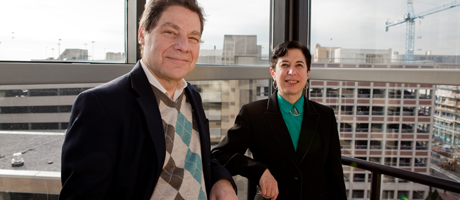By Jamie L. Freedman
The GW Solar Institute made substantial strides during its inaugural year—solidly positioning itself as a global leader in the fast-growing solar energy field. On the policy front, the institute forged strong working relationships with key policymakers and organizations in Washington and was heavily involved in discussions to shape the direction of U.S. solar policy.
The group’s education and outreach efforts have been equally successful—helping to increase awareness of solar energy as an important item on the world agenda. In the research arena, the institute funded a variety of GW projects that achieved significant research results on technical, economic, legal and policy issues associated with developing and deploying solar power, some of which are already contributing to policy initiatives.
A research team at GW’s School of Engineering and Applied Science, for example, recently identified extensive opportunities for the Department of Defense to develop solar energy use at its facilities and in its non-tactical vehicles.
On the communications and outreach front, the institute established a comprehensive Web site, which highlights its activities and serves as a clearinghouse for information on solar and renewable energy. The group also created a blog—The Solar Review--and has accounts on both Facebook and Twitter.
“We’re here to provide the big picture on solar energy, to conduct studies that build up the field’s knowledge base, and to be the trusted source of information in the field,” says international solar expert Ken Zweibel, director of the institute. Mr. Zweibel led the National Renewable Energy Laboratory's Thin Film PV Partnership Program and co-founded a thin-film photovoltaic manufacturing firm, which was later purchased by General Electric, before taking over the reins of the new institute in 2008.
Early highlights of his tenure at GW include serving on the steering committee of the U.S. Department of Energy’s Solar Vision study, a major effort to develop a 20-year roadmap to accelerate the deployment of solar energy in the United States, as well as testifying on Capitol Hill in July 2009 on the need for the development of a solar research and development roadmap. He also participated in three key meetings of the National Academies focusing on the status and direction of the DOE’s Solar Energy Technologies Program.
Mr. Zweibel was joined by co-director Debra Jacobson in September, whose career includes 30 years of experience in energy and environmental law and policy. “Debra’s experience will increase our ability to lead research efforts within the GW community as well as to conduct outreach to policymakers and the environmental community,” Mr. Zweibel says.
The institute, housed in GW’s Columbian College of Arts and Sciences, is hard at work on many fronts in 2010. “In the coming year,” says Ms. Jacobson, “I expect the Solar Institute to expand its contribution to the development of U.S. solar policy, to the analysis of critical issues, and to public education in the solar energy field.”
Final planning is currently underway for the institute’s annual symposium on April 19 at the Jack Morton Auditorium, which will bring together policymakers, as well as experts from the solar energy industry, academia and utilities. A major focus of the symposium will be the development of a solar vision through 2030 for the United States. Look for registration information on the institute’s Web site.
Last year’s symposium drew a packed house of 300 attendees and included luminaries such as German parliamentarian Hans-Josef Fell, U.S. Rep. Gabrielle Giffords (D-Ariz.), FERC Chairman Jon Wellinghoff, media mogul and environmentalist Ted Turner, and other leaders in energy policy and technology.
“The Solar Institute has a perfect home here at GW,” says Peg Barratt, dean of the Columbian College of Arts and Sciences. “During its inaugural year, the institute did an outstanding job of gathering experts in many fields, joining faculty and students in collaborative research, and putting trusted, scientifically sound information about solar energy before a large group of stakeholders here in D.C. and around the world. We look forward to much success in the years ahead as we continue to examine solar’s possibilities.”


